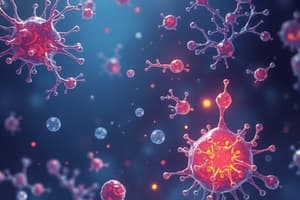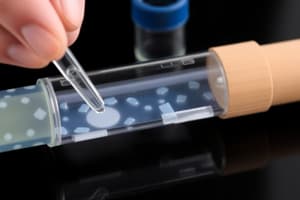Podcast
Questions and Answers
What is the purpose of the catalase test in bacterial species differentiation?
What is the purpose of the catalase test in bacterial species differentiation?
- To test the antibiotic resistance of bacteria
- To measure the sugar fermentation ability of bacteria
- To identify specific bacterial species based on their reaction to hydrogen peroxide (correct)
- To determine the pH tolerance of bacteria
Which bacterial species is known to exhibit a positive catalase reaction?
Which bacterial species is known to exhibit a positive catalase reaction?
- Staphylococcus aureus (correct)
- Streptococcus pyogenes
- Clostridium difficile
- Escherichia coli
How can one differentiate between Staphylococcus aureus and Streptococcus pyogenes using the catalase test?
How can one differentiate between Staphylococcus aureus and Streptococcus pyogenes using the catalase test?
- By observing bubble formation after adding hydrogen peroxide (correct)
- By examining the shape of the bacterial cells under a microscope
- By measuring the growth rate in different liquid media
- By counting the number of colonies under a microscope
What does a positive catalase reaction indicate in bacteria?
What does a positive catalase reaction indicate in bacteria?
Why is it important to differentiate between different bacterial species?
Why is it important to differentiate between different bacterial species?
Which bacterial species is known to be catalase-negative?
Which bacterial species is known to be catalase-negative?
What does a negative catalase result indicate?
What does a negative catalase result indicate?
How does the catalase test help in identifying Staphylococcus aureus?
How does the catalase test help in identifying Staphylococcus aureus?
What happens when hydrogen peroxide is added to a catalase-negative organism?
What happens when hydrogen peroxide is added to a catalase-negative organism?
Study Notes
The Catalase Test for Staphylococcus aureus
The catalase test is a crucial method for differentiating between various bacterial species, particularly when it comes to separating Staphylococcus aureus from other staphylococci and streptococci. This test involves adding hydrogen peroxide (H₂O₂) to a sample of bacteria and observing if any bubbles (oxygen gas) form. Different species react differently based on their ability to produce the enzyme catalase, which breaks down H₂O₂ into oxygen and water.
Catalase Enzyme and Bacterial Species
Staphylococci, including Staphylococcus aureus, typically exhibit a positive catalase reaction. As mentioned in search result, a positive reaction is characterized by bubble formation after adding H₂O₂ to a microbe on a slide glass or in a liquid media. This indicates the presence of the enzyme catalase, which is a valuable characteristic for identifying Staphylococcus aureus and other catalase-positive staphylococci.
However, it's also important to note that some bacteria, such as Streptococcus pyogenes and other streptococci, are catalase-negative. A negative result, where no bubbles form, is a sign of a catalase-negative organism. This can be useful in distinguishing Staphylococcus aureus from other bacteria that may be present in a sample.
Differentiation of Bacteria and its Importance
The ability to differentiate between different bacterial species is essential for medical and scientific purposes. Understanding the characteristics of each species, such as catalase production, can help determine their potential pathogenicity, virulence factors, and appropriate treatments. For example, Staphylococcus aureus is known to cause various types of infections, including skin lesions, deep-seated infections, hospital-acquired infections, food poisoning, and toxic shock syndrome. Being able to identify this bacterium using tests like the catalase test provides valuable information for healthcare professionals and researchers.
Studying That Suits You
Use AI to generate personalized quizzes and flashcards to suit your learning preferences.
Description
Learn about the catalase test, a method used to differentiate bacterial species like Staphylococcus aureus based on their ability to produce the catalase enzyme. Understand how bubble formation in the presence of hydrogen peroxide helps identify catalase-positive bacteria and distinguish them from catalase-negative organisms.




